“Red-Dot” type optical sights have been around since the 1970’s, and they have taken a long evolutionary roller coaster ride to bring us to the products of today. Tube-style sights such as the early Aimpoint and Tasco Pro Points have given way to smaller Aimpoint H-1/ T-1s, and the original Bushnell Holosights evolved into the modern products of EoTechs and lightweight C-More sights. Every optics manufacturer worth its salt has a 1x dot sight these days.
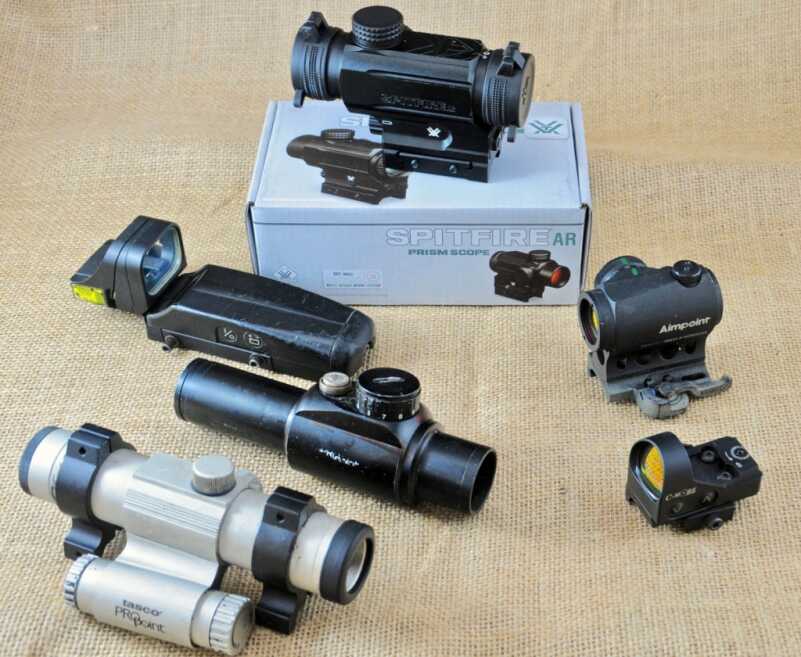
40 years of red dot sight evolution has brought about vast improvements, resulting in sharper clearer images, longer battery life, and greater versatility.
One power optics are designed to be shot with both eyes open for rapid, close-range target engagement. Having a single aiming point eliminates sight alignment errors and allows the focus to be on the target rather than on a front sight, making them surprisingly accurate to shoot. Their lightweight and small size make them a perfect match for mounting on short to medium range AR platform firearms.
Evolution
Vortex’s new contender in the 1X arena isn’t even a true vintage style Red-Dot sight at all. It is actually a small one power prismatic scope. It isn’t dependent on shining LEDs, lasers, or fiber optic transmitted light upon a lens to create an aiming point. It has an etched reticle that is present without artificial illumination, though it does have supplemental illumination to aid in low lighting conditions.
The Spitfire AR Prism 1x scope can be used even if you forget and the battery goes dead in the field. Flip-up lens covers ensure a clear view of the etched reticle.
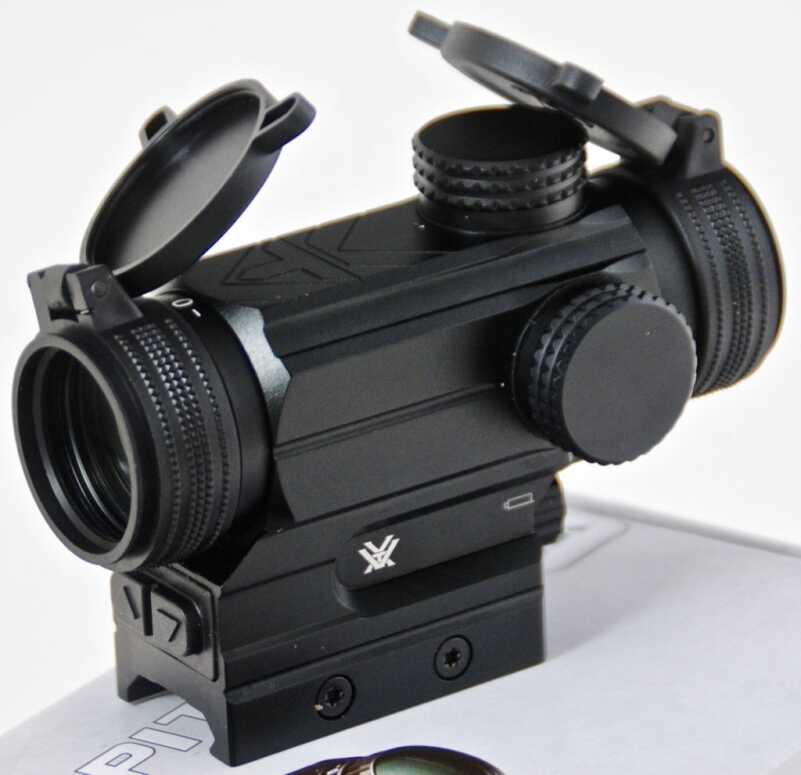
The Spitfire AR Prism 1x scope can be used even if you forget and the battery goes dead in the field. Flip up lens covers ensure a clear view of the etched reticle.
Design Upgrade
The Spitfire AR is the newer, upgraded version of the previous Spitfire. Significant changes are easily seen between the two versions. The battery type was changed to a readily accessible AAA from the flat style 2032. It was also moved from the top of the scope to the riser section below the line of sight, making use of the necessary but previously wasted space.
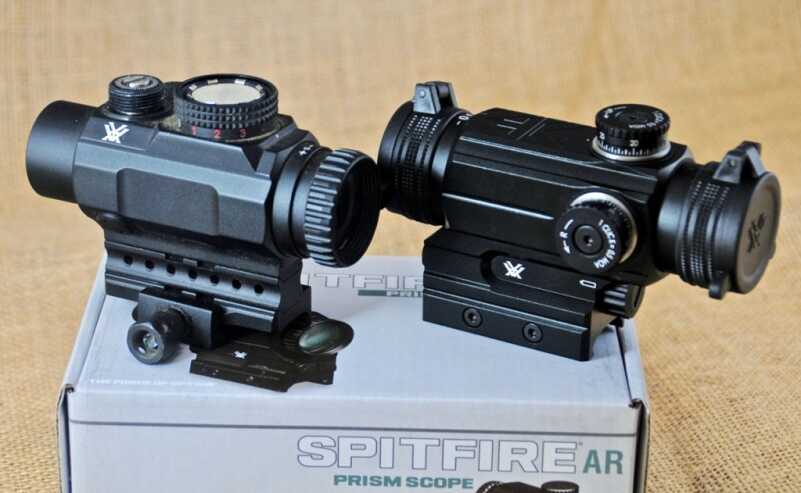
Updated Spitfire AR has a one-piece body rather than a separate base, riser and optic of the previous Spitfire enhancing reliability.
Controls for the illumination were moved from the top mounted rotary switch to rear mounted push buttons. The mounting base itself was improved by going to a two screw arrangement that has a greater clamping surface area from the one large locking nut, adding redundancy and streamlining a bit.
Windage and elevation turrets were made larger and better defined to make zeroing and hold over adjustments much easier.

Rear mounted illumination buttons control intensity and color of reticle. Spitfire AR allows switching between red or green illumination.
A common issue with typical red dot sights is that the dot is usually not a nice perfect round aiming point. Often times it is flared out like a small sun in the lens or in my case due to astigmatism it is somewhat oblong, both conditions making it difficult to use for more precise shots at distance.

3 MOA center dot is easy to find when shooting and allows accurate aiming, shown here 50 yards. The larger outside rings of DRT reticle make for fast engagement of closer range targets.
The clean crisp etched reticle of the Spitfire corrects this issue for me and provides a relatively precise aiming point. The 3 minute of angle (MOA) center dot proved large enough to be seen and used for shooting at ranges of 300+ yds. The larger circles around the center dot can be picked up rapidly for closer targets.
Knowing the center dot of the reticle is 3 MOA allows for it to be used to help gauge holdovers for shooting at distance. The 3 MOA dot covers 3” at 100 yards and therefore would be 12” at 400 yards; providing a rough measuring stick that allows target engagement to at least 400yds.
However, the Spitfire AR has a second dial provided for the elevation turret that is labeled for use as a 5.56 Bullet Drop Compensator (BDC), allowing you to dial elevation if desired rather than holding over. Simply remove the Torx screw and replace the MOA dial with the BDC dial and set the 1 at your 100 yard zero and tighten back in place.
BDC’s are typically based on a particular bullet (design/ weight) at a specific velocity so there will always be a certain error margin due to using bullets with a different Ballistic Coefficient (BC) or at a different velocity due to powder charge or barrel length. However, on reasonable sized targets and distances, this one gets hits.

BDC Elevation dial proved accurate enough to get consistent hits on targets out to an 8” plate at 300 yards and tracked properly back to 100 yard setting.
Specs
- Magnification- 1x (none)
- Length- 3 inches
- Weight- 2 oz.
- Objective Diameter- 25 mm
- Diopter Adjustable Eyepiece
- Reticle- Dual Ring Tactical (DRT)
- Reticle Color BLACK (Non-illuminated), Red or Green (Illuminated)
- Reticle Center Dot- 3 Minute Of Angle (MOA)
- Reticle Inner Circle- 44 MOA ID / 6 MOA thickness (Internal Diameter)
- Reticle Outer Circle- 140 MOA ID / 3 MOA thickness
- Eye Relief- 8 inches
- Adjustments- .5 MOA
- Field of View- 79 feet @100 yards
- Illumination- 12 settings (Lowest 2 suitable for night vision use)
- Power Supply- AAA battery (1)
- Battery Life- 250-3000 hours (power setting dependent)
- Warranty- Lifetime
- MSRP- $349.99
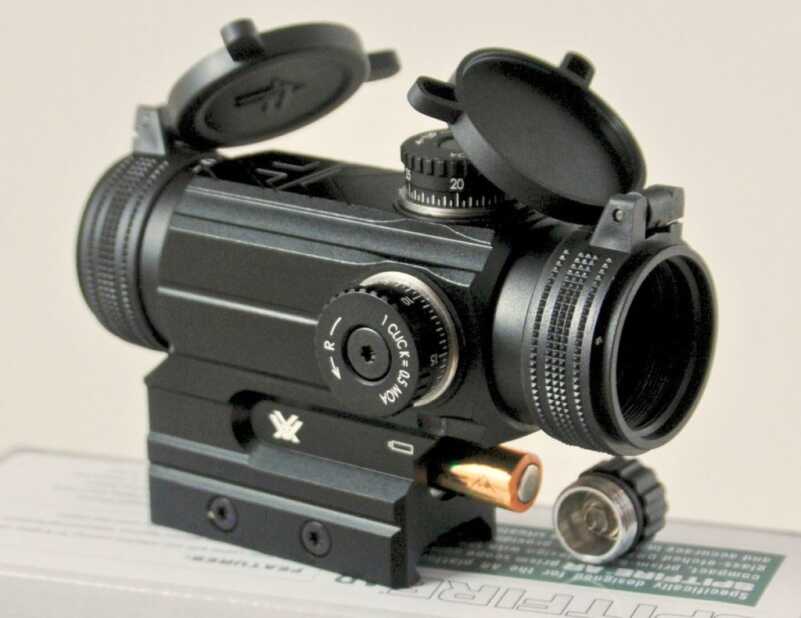
Well marked windage and elevation turrets made point of impact adjustments for zeroing easy. AAA battery compartment can be seen in the riser part of the scope base.
Range Testing
Since the center dot is 3 Minute of Angle (MOA), about 3” in diameter I zeroed the optic on my rifle for a point of impact at the very top of the center dot at 100 yards rather than some random point hidden under the dot. This worked out well with the bullet drop for groups at 200 yards to hit around the center of the dot.
Hits on steel targets from 100 to 250 yards were as simple as putting the dot on the target and pressing the trigger, resulting in the satisfying ring of bullet on steel. The 300 yards targets, though harder to see with no magnification, proved almost as easy since the 3 MOA dot was now covering 9” of the target and the bullet drop was about 10”; I merely covered the upper half the target and bullets fell into the steel just below the bottom edge of the dot, like rain from the sky.
Engaging the 300 yard steel by turning the BDC elevation dial to 3 also resulted in hits on the 8” plate by aiming directly at the plate. The Spitfire offers quite a bit of versatility and performed well at the distances tested.

Some of the groups shot while zeroing in with Hornady 55 grn Steel Match ammunition at 100 and 200 yards. Top right 100 yard 5 shot group was 1.24”, 200 yard group on left target was 3.16”.
Beyond 300 yards the challenge became having good target definition to engage. Freshly painted targets or targets contrasting the background were surprisingly easily engaged to 400 yards. At 400 the trajectory of the bullets was 2 feet low since the center dot now covered 12” at that distance it was just a matter of holding two diameters above the desired point of impact.
Once some paint was knocked off and the targets were greyed a bit, it was difficult to get the definition needed for proper holdovers even though the reticle could be clearly seen.
This is partly due to light transmission losses through the scope- these losses are present with all scopes. Often times you can see a target when looking at it with the naked eye, but looking through a non-magnified optic it becomes more difficult. This is due to the fact that the light transmitted through any scope decreases as it passes through the multiple lenses.
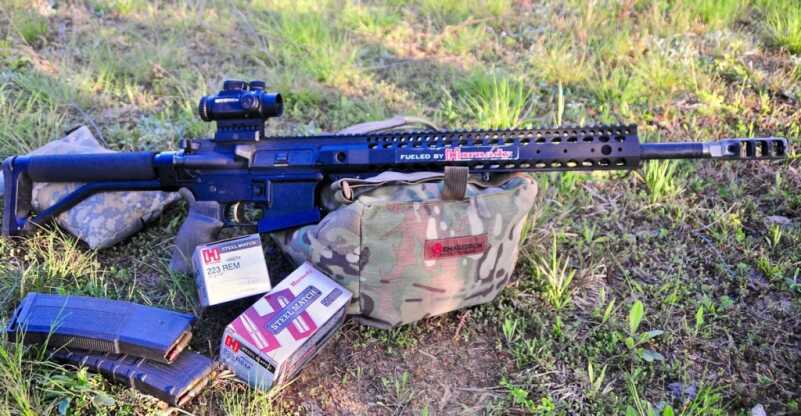
Old style Spitfire performed well but was challenging at times to get zeroed due to 1 MOA turret adjustments and small turrets- Spitfire AR corrected both these issues along with other improvements.
The majority of the shooting was done with the black non-illuminated reticle, and it worked very well. The variable powers of illumination did, however, prove beneficial as the sun moved closer to the horizon and shadows reached across the range and the targets. Long before true darkness fell the black reticle began to be harder to pick up so the illumination came on and the hits continued.
The illumination proved bright enough to easily be seen in full sunlight and was easy to dial down so it was not overpowering as the sky dimmed. This would be excellent for hunting in the early or late hours of the day.
The illumination has 12 levels of brightness but the bottom two are very dim for use with night vision. I looked through the scope with a PVS-14 unit and found it worked best with the night vision mounted in front of the optic.
Mounted in this configuration no illumination was necessary as the black reticle was easily seen and shooting in this manner under normal moonlight would be easy to at least 100 yards. This would make an excellent combination for close range night hog hunting.
The reticle illumination is turned on by pressing either button and turned off by holding both buttons down for 3-4 seconds. The scope also has an auto shutdown feature that dims it after 2 hours and shuts it off after 4 to save battery life.
Final Thoughts
Overall, I was extremely impressed with the Spitfire AR scope’s performance. I was able to shoot surprisingly small groups at varying distances with the non-magnified optic and able to successfully engage targets to 400 yards while it felt like it added very little weight to the rifle.

Rear (Ocular) lens allows adjustment of reticle focus to suit the user’s eyesight. Dual mounting screws hold the scope securely to the rifle for hard use.
The rifle was obviously less top heavy compared to shooting it with a low power variable scope and the handling was fast and nimble. With the large field of view and the illumination turned on the Spitfire AR was blazing fast on up close speed drills doing rapid target transitions. So all in all, the scope did what it was supposed to and gave me no issues. I think it is a great offering from Vortex.
It may not be a battle-tested veteran like the Aimpoint or the EoTech but it doesn’t cost as much either. Only time will tell if the Spitfire AR has the dependability and staying power as the other red dots that have had decades to evolve to the products of today.
Though we hope we never need it, the Spitfire AR does come with the Vortex VIP Warranty- lifetime, and unconditional repair or replacement. In an age where many times you have to purchase extended warranties or electronics are only covered for a short period of time, this is a manufacturer standing behind their product.
For more information about Vortex click here.
***Shop GunsAmerica for Vortex Optics***[/track-link]
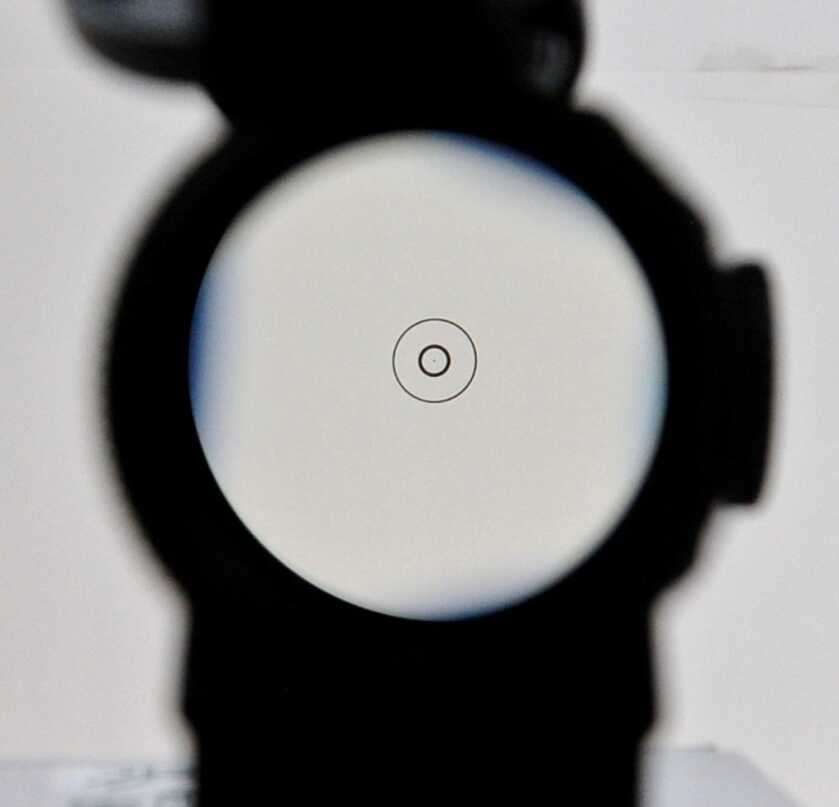
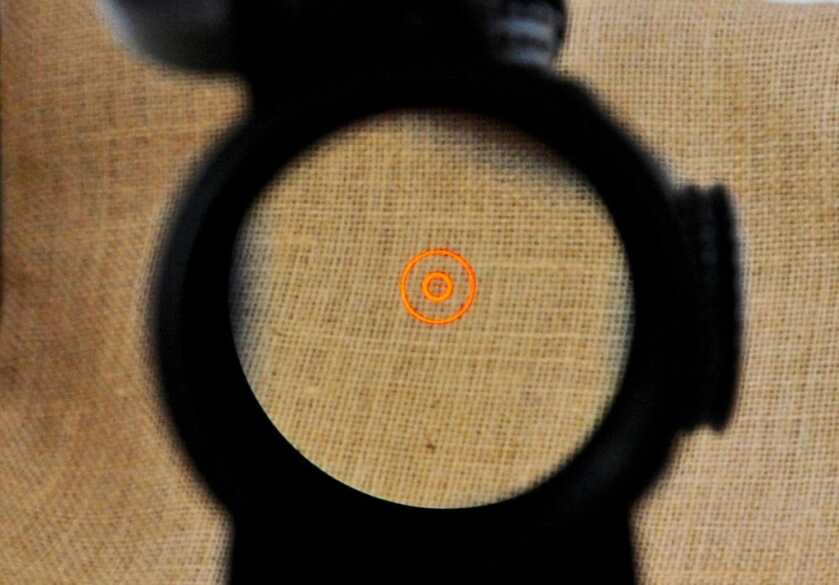
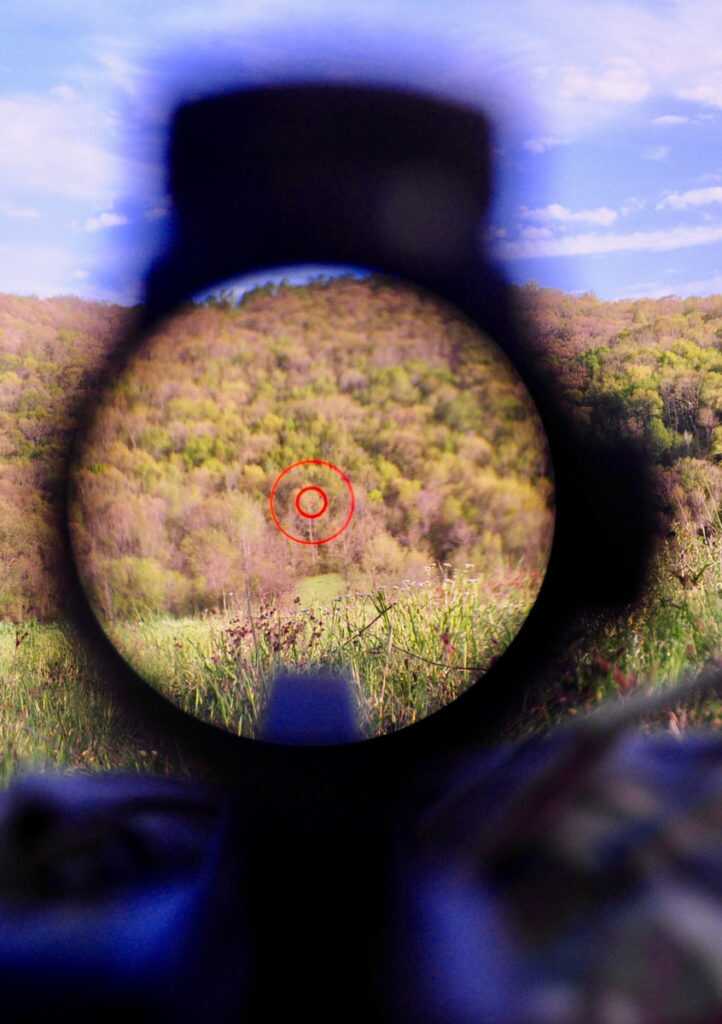


I’m old school. Ok, hell I’m old. I’ve never used any of these electronic sights or sight-systems. I have however accepted that it’s time to join the modern world and give ’em a shot (no pun intended). Picked up a new Glock 41 recently for $300, so unless I can find a deal, it looks like I’ll have almost as much in the optic. Same with my AR – I picked up a new Ruger AR556 for $400. I’m going to use these (2) guns for my optic trials and leave all my other guns the hell alone – iron only. We’ll see how this goes. Wish me luck.
I almost purchased this, until I saw that the optic had been “updated” to a 1-piece body with attached riser. This limits it’s application to a conventional AR rifle, as the one-piece body makes it impossible to mount low on a conventional stock firearm, such as a shotgun, the Fight Lite SCR or any other such firearm.
The competing Primary Arms 1X prism sight will mount on any standard micro dot base or riser.
The reticle of this optic sucks in my opinion. I found it too busy with 2 outer rings vs my Eotech’s 1 ring reticle. Also, it’s not true 1X and had the fisheye effect. So glad I sold mine and purchased the 3X magnified prism scope from Primary Arms.
MD,
What do you mean by a true 1X? 1X has ZERO magnification.
I own an original Spitfire with a graduated sight reticle. I’ve engaged static targets from 100 to 400 yards using the suggested elevation markings. Can’t say I’m particularly excited about the new version, wasn’t broken, so why fix it?
Here here sir. I have the older one as well. Shorter, lighter, and the best reticle out there for steel plate challenge or three gun “bay” matches. Ability to be mounted on a S&W 15-22 or a Beretta CX4 without a cheek riser. Either model should’ve had a qd mount. However you are correct, it wasn’t broken, until now.
I think you’ve under glassed that long barreled AR; as you are using a red-dot, I assume you anticipate engaging closer than 400 yards.
Which brings up those turrets. I understand enlarging them as an attempt to facilitate adjustment, but it seems the same error was made in that attempt as was made in using a red dot on the aforementioned long-barreled SPR: trying to be good at all things by sacrificing some of the strengths of each.
TO me, if you need that kind of adjustment, maybe you need more glass. IF you want the speed of a red dot, having snag points, like those turrets present, is not a good option. The reticle with the double circles is a good choice as it allows for hold off references.
My cheap TruGlo works just fine and it was only 42 bucks. I have a problem paying more for optics than I do for a gun.
I use a very old TruGlow Dot. It has worked very well until recently, now upon the shot it dims for a second then goes back to selected brightness. I can’t complain: $49 and 10+ years of hard use, still hangung in there. Will replace with a newer version TrueGlow soon and put the old one on a plinker.
I agree with you. Centerpoint makes a decent red dot.
But when it comes to glass, you get what pay for. I have several inexpensive scopes and one expensive Leupold. The difference in clarity at 500 yards is amazing.
Nice article and finally something the average middle class, hard working, tax paying American can afford.
Exactly why I like Vortex: decent quality for a decent price. Just what the average shooter needs